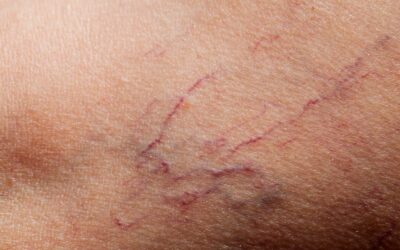Chronic venous insufficiency lies at the root of problems such as varicose veins, spider veins, venous ulcers, and more. This beginner-level guide will discuss the definition of chronic venous insufficiency, what causes it, and how you can treat it naturally and with vein procedures.
What is chronic venous insufficiency?
When your legs no longer supply blood back to the heart efficiently, it is known as chronic venous insufficiency. Usually, the valves in the veins make sure blood flows only in the proper direction, but, at times, blood flows backward. Blood pools in the veins, and symptoms appear over time.
Going long periods without addressing chronic venous insufficiency can lead to:
- Pain
- Swelling
- Cramps
- Skin Changes
- Varicose Veins
- Leg Ulcers
Chronic venous insufficiency is not a health threat, but it can become painful and disabling if left untreated, leading to other issues.
How is chronic venous insufficiency caused?
There is not a direct cause, only some lifestyle choices that, over time, can lead to poor blood flow and insufficient vein activity. You are at a higher risk of this developing if you:
- are overweight
- are pregnant
- have chronic venous insufficiency in your family history
- had damage to the legs from injury, surgery, or blood clots.
- have an inactive lifestyle, causing high blood pressure in the leg veins over time
-
don’t get enough exercise
- smoke
- have blood clots in the deep vein, often located in the calf or thigh
- have swelling and inflammation of veins closer to the skin, usually in the legs
What are the symptoms of chronic venous insufficiency?
Symptoms that come with chronic venous insufficiency include:
- swelling of the legs and ankles
- a feeling of tightness in the calves and legs and feelings of itchiness
- pain when walking
- discoloration of the skin near the ankles, showing as a brownish color
- development of varicose veins in the legs
- venous leg ulcers and sores developing on the surface of the skin
- uncomfortable feelings in the legs and an urge to move the legs (restless leg syndrome)
- leg cramps and muscle spasms in the legs
How can chronic venous insufficiency be treated?
Based on the situation, natural and procedural treatments for chronic venous insufficiency are employed.
Natural remedies for chronic venous insufficiency are
Compression Socks and Stockings
Every patient dealing with venous insufficiency should use compression socks. A good pair of compression stockings can reverse the heaviness of the leg, aches, pains, fatigue, and swelling. They can also address the tenderness associated with varicose veins and spider veins.
Exercise
Keeping active gets your blood pumping, literally. Your veins depend on contractions in the muscle to return deoxygenated blood to your heart from the extremities. Without exercise, your circulation is not optimal. Low impact exercises are practical. Simple walking and swimming are great ways to get your blood pumping.
Elevation
Elevation uses gravity to bring blood back in the right direction and back toward the heart. Your legs will often feel less achy and swollen. You can often see a reversal of symptoms from simple elevation at the end of a long day. The height is significant when work has you on your feet or live a primarily sedentary lifestyle (working from home, for example).
Skincare
Unhealthy veins often come with dry and itchy skin. You can develop rashes, infections, and wounds. Good skincare to keep veins healthy includes hydration, avoiding unnecessary chemicals, and changing to a clean pair of compression socks each day.
Vascular procedures to treat chronic venous insufficiency
When natural remedies prove insufficient, several options for treating vein issues, ranging from minimally invasive to surgical techniques.
Venous ablation
Venous ablation involves the use of heat to damage the vein, causing it to close off, eventually reducing the appearance of the veins or completely removing them from view.
Varithena
Varithena involves injecting the varicose veins with a chemical foam to close off the residual veins left after venous ablation.
Sclerotherapy
Sclerotherapy is a minimally-invasive, non-surgical procedure used to treat venous insufficiency. A solution enters the blood vessels via injection, causing them to shrink.
Phlebectomy
Phlebectomy is a minimally invasive procedure where we use a small scalpel or needle to manually remove the varicose veins below the skin’s surface.
Venoplasty
Venoplasty is a surgical procedure that inserts an inflatable apparatus, widening the vein and increasing blood flow.
Venous Stenting
Venous stenting is the insertion of metal mesh tubes, which expand against the blocked or narrow vein walls. They keep the vein open to blood flowing.
Vein treatment in Columbus, Ohio, with Columbus Vascular Vein and Wound Center
If you are experiencing symptoms of chronic venous insufficiency, get in touch with us to set up a consultation to discuss your veins and how to treat them in the least invasive way possible.
Call today or submit a form to get started.



